Economic indicators such as family income, home ownership and union membership are all associated with partisanship.
Partisanship by income groups
Democrats have a substantial advantage over Republicans among voters in the lowest income tier, and a modest advantage among those at the highest income tier:
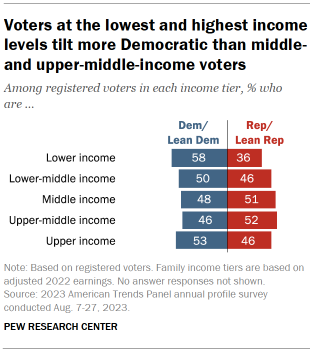
- About six-in-ten voters with lower family incomes (58%) associate with the Democratic Party, compared with 36% who affiliate with the Republican Party.
- Among upper-income voters – those on the other end of the income spectrum – 53% are Democrats or Democratic leaners, while 46% are Republicans or GOP leaners.
But Republicans have a modest edge among upper-middle-income voters. Voters in the lower-middle tier and those squarely in the middle of the income distribution are roughly evenly split in their partisan orientation.
Read the methodology for more about income tiers, which are adjusted for household size and cost of living.
The relationship between income and partisanship differs by education
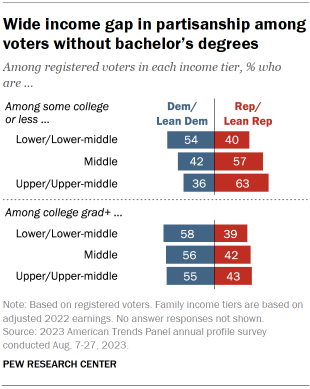
Among voters without a bachelor’s degree, higher income is associated with being more Republican. But there are no income differences in partisanship among college graduates.
While voters who do not have a bachelor’s degree tilt Republican overall, this differs across income groups.
Among voters without a college degree, those who are in the lower or lower-middle tiers of family incomes are more likely than those in the middle and higher income groups to associate with the Democratic Party.
- A 54% majority of voters without a college degree who are lower or lower-middle income are Democrats or Democratic leaners.
- By contrast, 57% of voters without a college degree who are middle income and 63% of those who are upper or upper-middle income associate with the Republican Party.
College graduates’ partisan allegiances do not differ by income level:
- By similar-sized margins, majorities of voters with a bachelor’s degree or more in all income groups associate with the Democratic Party.
Union members remain more Democratic than Republican
Union members have long been a Democratically oriented group – and that remains the case today.
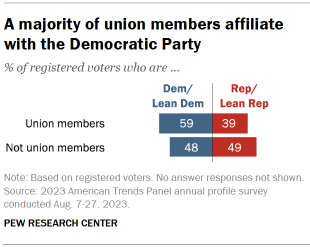
Today, nearly six-in-ten voters who belong to a union (59%) associate with the Democratic Party, while around four-in-ten (39%) identify with or lean toward the GOP.
Voters who do not belong to a union are about equally likely to associate with each of the two parties: 49% are Republicans or Republican leaners, while 48% are Democrats or Democratic leaners.
Homeowners are more Republican than renters
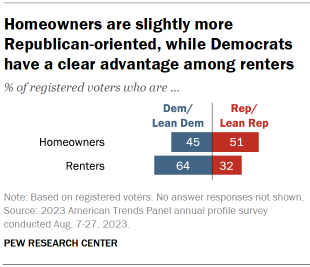
About half of voters who own a home (51%) align with the GOP, while slightly fewer (45%) are Democrats or Democratic leaners.
Voters who rent, however, favor Democrats by two-to-one: 64% of voters who rent their home associate with the Democratic Party, while 32% identify with or lean toward the Republican Party.
Partisanship of military veterans
Voters who are military veterans favor the Republican Party: 63% identify with or lean toward the GOP, while far fewer (35%) are Democrats or Democratic leaners.
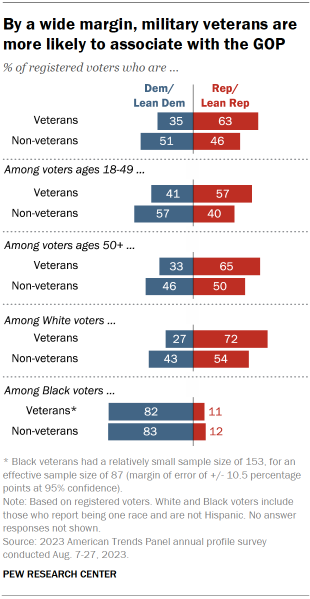
Non-veteran voters tilt more Democratic: About half (51%) associate with the Democratic Party, while 46% affiliate with the Republican Party.
The Republican Party’s relative advantage among veterans is seen among both older and younger voters. In both groups, veterans are about 15 percentage points more Republican-oriented than non-veterans.
Similarly, among White voters, veterans are substantially more Republican-aligned than non-veterans. Around seven-in-ten White veterans (72%) identify with or lean toward the Republicans. By contrast, 54% of White non-veterans are Republicans or GOP leaners.
In contrast, among Black voters there is no difference in the partisanship of veterans and non-veterans (about eight-in-ten in both groups associate with the Democratic Party).




